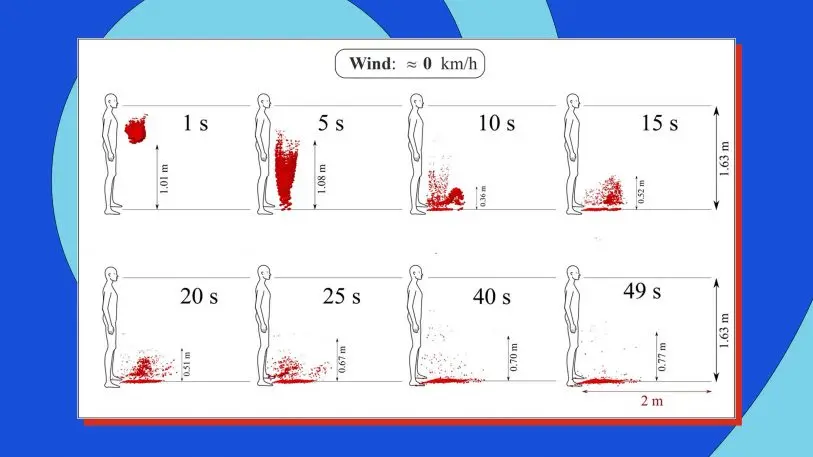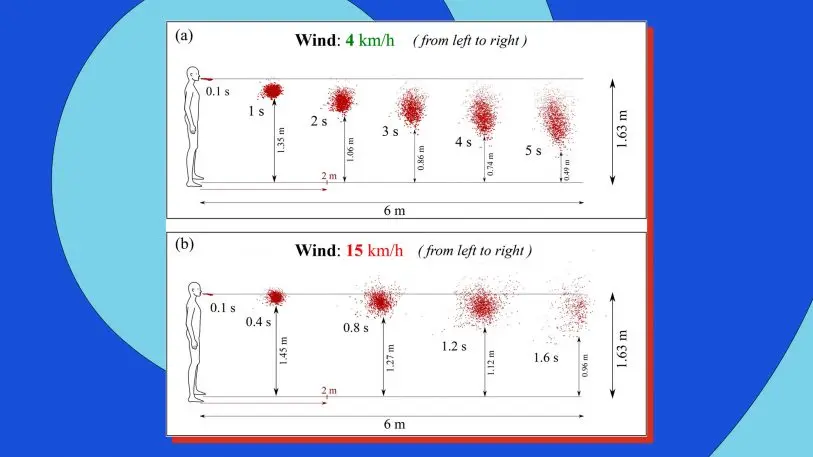As the world opens back up, even with COVID-19 in an unrelenting swing, one guideline is repeated again and again: Keep six feet of social distance. And this number makes us feel safe because it comes from the authorities. But this number is, according to a new study, inaccurate and flawed.
The World Health Organization recommends a three-foot distance to avoid the potential spread of COVID-19 through droplets in the air, be it from coughing, sneezing, or even speaking. But where does that recommendation come from? According to Quartz, one study that’s nearly 100 years old. In 1934, the Harvard School of Public Health built an apparatus to capture droplets flying from your mouth through the air. The results of that test stand as the status quo today, though the CDC doubles the spans, to recommend six feet of social distance between people.
But a new study published in Physics of Fluids, which used a sophisticated simulation to model the aerosol spray from a cough, is here to challenge both WHO and the CDC’s conventional wisdom. “What we show is we have a significant amount of droplets that can travel beyond [six feet] in a short period of time,” says Dimitris Drikakis, professor at University of Nicosia, Cyprus. “This is something we need to take into account.”
The simulation that Drikakis and his colleague built is technically advanced and accounts for all sorts of variables across physics and fluid dynamics. It includes several mathematical models to simulate air turbulence, humidity, and evaporation. The scientists even filmed a mouth coughing with a high speed camera, so that they could accurately duplicate its shape inside the simulation.
“We chose a cough instead of a sneeze because a sneeze is more violent but less frequent,” says Drikakis. “So we chose a cough because it’s more common, and we chose a mild cough because a more mild cough is more common as well.”
What the study found was that, with no wind, droplets from a light cough will fall to the ground within six feet. These results fall within WHO and CDC best practices for social distancing, and those old Harvard lab results.


Indeed, scientists and doctors generally concur that COVID-19 can be transmitted through these droplets, but as Drikakis says, there’s no firm science about the amount of the virus and the length of exposure that it takes to actually acquire the illness. Still, you can clearly see from the above charts that the density of the droplet cloud does decrease over distance—especially in higher winds—which implies that adding extra social distancing could help ensure public safety.
In the long-term, Drikakis imagines we’ll need to rethink our public spaces during pandemics, knowing that these droplets can spread farther than previously thought. But most of us are wondering what we can do now, knowing that aerosols spray farther than previously considered—just as summer is around the corner and much of America is opening back up?
“I don’t think we have to panic and stay [20, 30, or 300 feet] away. We don’t know exactly what is the amount of droplets and the amount of virus that will infect you,” says Drikakis. “The thing I’d recommend as a common person is, if you’re in a place, and there’s a light breeze or strong wind, and you’re going to sit close to someone . . . take this into account.”
As for Drikakis himself, seeing the data he compiled firsthand, he says he would not sit down six feet away from a stranger in a breeze. “But it’s a very personal thing,” he says. “It’s difficult to give recommendations on how to live your life.”
Recognize your brand’s excellence by applying to this year’s Brands That Matter Awards before the early-rate deadline, May 3.